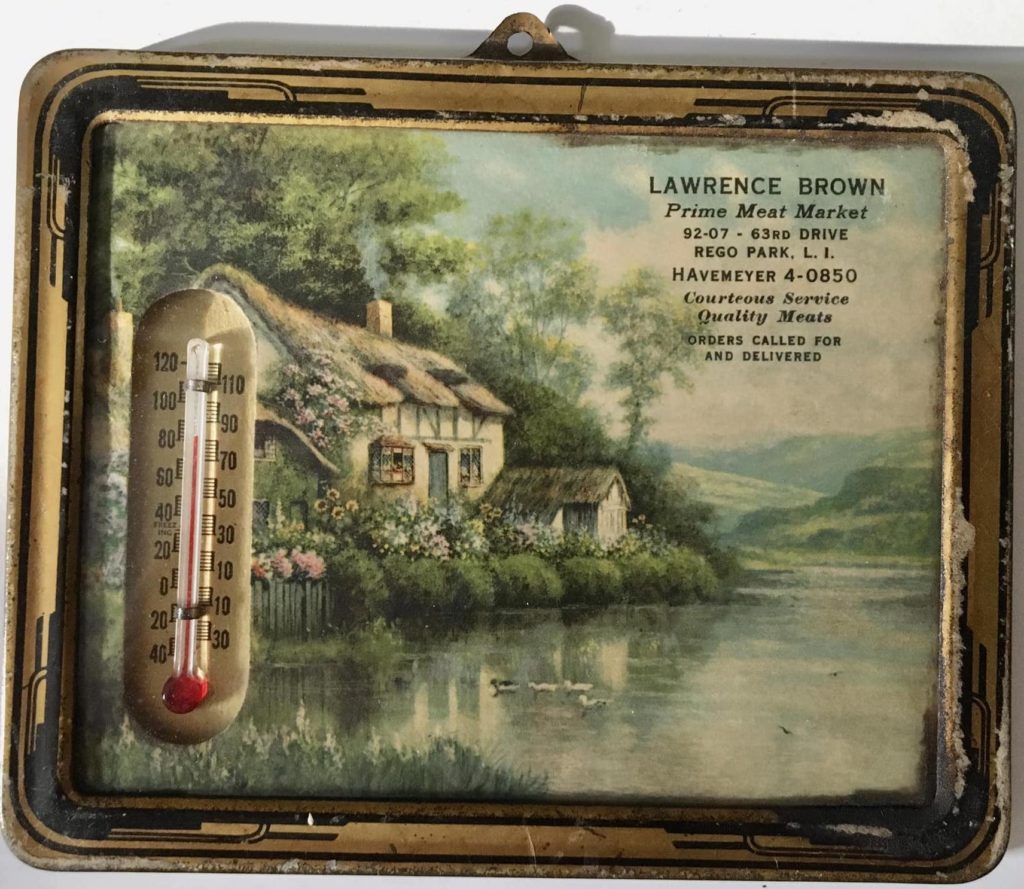From functional thermometers to collectible art
By Michael Perlman
mperlman@queensledger.com

Lawrence Brown Prime Meat Market circa 1940s, Rego Park.
Some vintage items may be collecting dust, but think twice about tossing them — since they may hold artistic, historical and financial value.
Such is the case of long-forgotten “advertising thermometers,” which were advertised in newspapers in the late 1890s, while keeping in mind that Daniel Gabriel Fahrenheit invented the modern thermometer in 1714. These relics could be found locally and nationally.
In the 1890s, America was largely rural and other than postcards and trade cards, it was generally a challenge to advertise, but thermometers engaged the public in a unique way through design and could be readily observed and utilized.
In the 1920s, as towns and cities across America evolved from rural to more urbanized destinations, the analog thermometers became even more prevalent.
They were a popular form of advertising for everything from bakeries to liquor stores to meat markets, and from food, automobile, healthcare and photography industries to World’s Fair expositions.
Most came with hangers to display inside or outside a home.
After the 1980s, they dwindled in popularity, and increasingly so as a result of mass advertising and detecting temperatures through digital technologies.
Today, there is an average of 11,000-plus advertising thermometers on eBay at any given time, and they are indeed a hot commodity, which capture nearly every theme and size imaginable and sell anywhere from 99 cents to $8,345.

1942 Art Deco Coca-Cola advertising thermometer.
Some standout thermometers are a die-cut 1910s “Drink Moxie,” a St. Bernard washed coal, a girl drinking Coca-Cola in 1939, Snow White cream soda, OshKosh B’gosh Work Wear, a Norman Rockwell-themed 1984 General Motors Parts, a cartoon-like Nesbitt’s Orange Soda and “Plant Coker Hybrids.”
Decades ago, a business owner could not have predicted that what was offered to patrons as a promotional means, whether free or as a bonus alongside a purchase, would hold a high value for today’s collectors.
Often for local brands, rare early wood thermometers could be circular and nine to 12 inches in diameter, whereas a rectangular model could be astonishingly up to six feet.
Most frequently, they were 17 inches.
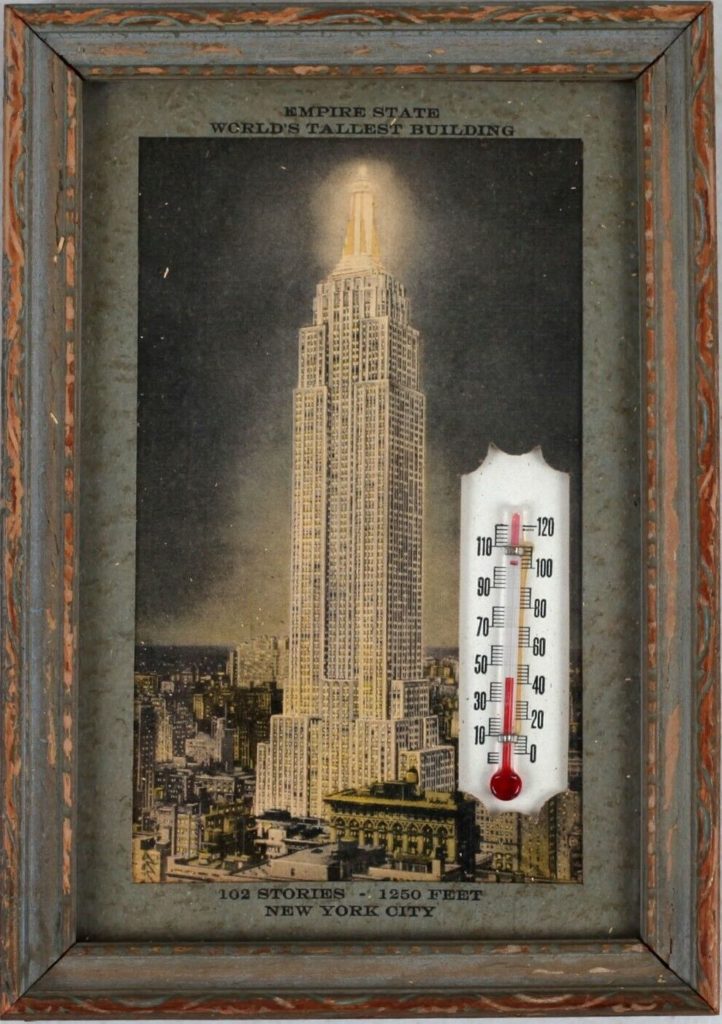
Empire State Building advertising thermometer.
Diverse shapes initiated character with round signs bearing clock-like hands, whereas others were vertical rectangles or squares.
Sometimes they resembled the products that they represented such as a bottle of soda.
It was the thought of advertisers that it would remain on display in a shop longer than a more predictably shaped advertising thermometer.
The outdoor models, which rose in popularity in the 1920s, especially for rural areas, enabled residents to determine not only the temperature, but wind direction.
Advertising thermometers can be found in styles including Colonial, Victorian, Art Nouveau and Art Deco.
Early models were manufactured from tin and wood, which somewhat transitioned to porcelain.
In the 1940s, Masonite was the preferred choice for drugstore advertising thermometers.
Some manufacturers’ names can be discovered in classified ads, if not evident on advertising thermometers.
An ad published in The New York Sun on Aug. 15, 1897 read, “Wanted — Our line of advertising thermometer novelties for 1897-1898 is now ready. We pay liberal commission to competent salesmen. Send 10 cents in stamps for catalogue, sample and terms. Taylor Bros. Co., Rochester, N.Y.”
“Where the good thermometers come from” was their slogan.
Taylor Instruments was founded by George Taylor, a Stoddard native in 1851.
In the early 20th century, their factories were not only in Rochester, but in Toronto, London, New York City, Chicago, Baltimore, Boston, St. Louis and Philadelphia.
The firm evolved into what is presently known as Taylor Precision Products, which is acclaimed in measurement products.
The Feb. 22, 1899 edition of Printers’ Ink — A Journal For Advertisers, featured a Taylor Bros. Co. ad, where an excerpt reads: “The wood thermometer has been used as an advertising medium for a number of years and is to-day a staple article. The force of the wood advertising thermometer lies in being able to read weather temperatures at a greater distance than is possible with small thermometers.”
It continues, “By omitting the words usually printed upon one side of the thermometer scale — ‘Zero,’ ‘Freezing,’ ‘Temperate,’ etc., and alternating the figures of the scale on either side of the tube, makes it possible to use figures more than twice as large.”
An illustrated Taylor Brothers Co. ad ran in The Magazine of Business in 1905, which read: “What will you give your customers this year? The best thing to keep your name before them is an Advertising Thermometer. More valuable than calendars or novelties because they are appreciated and work for you every day for years. Better pay 12 ½ cents for an attractive 7” x 2” aluminum thermo with your ad on (see cut) than one-half as much for a one-man or one-year advertisement. Our 56 page Catalog B of other styles free.”
Another ad, published in The Philadelphia Inquirer on Jan. 11, 1925 read, “Fastest selling advertising thermometer calendar combination, 17c, metal back, three colors, uncond. guarantee, money making sideline. Newton Mfg. Co., Dept 17, Newton, Ia.”
This firm was founded in 1909.
From 1940 to the early 1970s, a dominant manufacturer was the Pam Clock Company, which produced advertising thermometers and clocks for large firms, and epitomized the industry. Coca-Cola and RC Cola were among thousands of organizations that appointed the firm to illuminate their image.
“Go For Bunny Bread” and “Ask For Valvoline Motor Oil” are two classic examples of round Pam thermometers, which consists of a 14” aluminum housing with domed-glass crystal.
The analog dial would be customized by logos or slogans.
Along the lines of the Pam Clock, the thermometer was backlit with super bright LED lamps.
Forest Hills and Rego Park shops earned their spot in the advertising thermometer field.
These collectibles that were distributed at local businesses are hard to find nowadays.
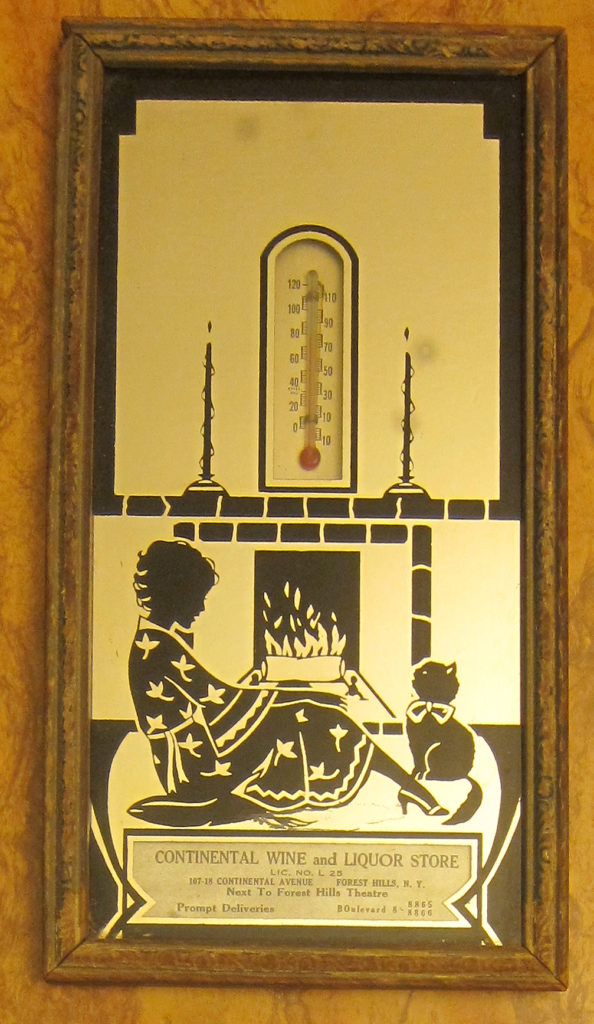
Continental Wine & Liquor Store, Forest Hills.
One example features “Continental Wine and Liquor Store,” which was located at 107-18 Continental Avenue and notes “Next to Forest Hills Theatre” in a nameplate accompanied by Art Deco detail.
It also ensures prompt deliveries and features a vintage phone number with a prefix: BOulevard 8-8865/8866.
The backing is wood and it features a carved frame that supports a colored mirrored surface.
The charming imagery consists of a woman sitting with her cat in front of a fireplace, and above the mantel are two candlesticks alongside a built-in thermometer. The manufacturer likely felt that this relaxing scene would complement any home’s décor while drawing one’s eye to the business.
Sometimes advertising thermometers tell a story that extends beyond a business, as in the case of the rare “Tilden Dairy and Delicatessen” collectible. This cherished business was located at 73-06 Austin Street and reads, “Everything from soup to nuts.”
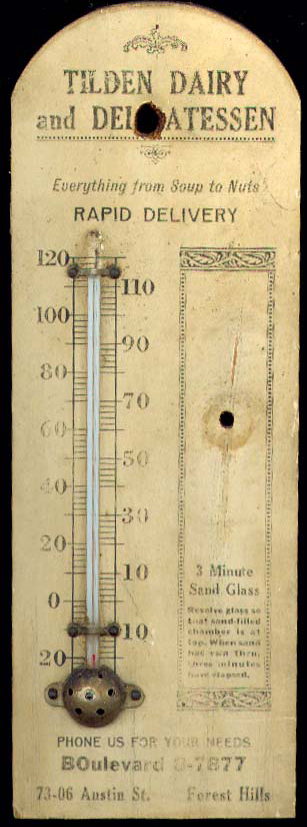
Tilden Dairy & Delicatessen at Tilden Arms, Forest Hills.
Besides a thermometer, a three-minute sand glass was attached, which came in handy in the kitchen.
It dates to the time when Austin Street was nicknamed “The Village.”
This business was named after Tilden Arms at 73-20 Austin Street, a Georgian Colonial apartment building, completed in 1931.
It takes an advertising thermometer to inspire further research, where one learns that it was named after “Big Bill” Tilden, who won the U.S. National Championships, with wins in Forest Hills in 1920, 1924, 1925 and 1929. That included the first year at Forest Hills Stadium.
He holds a record for the most men’s singles titles and was the first American to win Wimbledon in 1920.
Advertising thermometers are bound to come in unique shapes. A classic example is a supersized ornate brass key that supports a thermometer.
It reads “1939 World’s Fair” and embossed on top is a depiction of the Fair’s symbolic Trylon and Perisphere monuments, which reflects the multicultural and innovative “World of Tomorrow” theme and could also be found at the Trylon Theater, on stationery, on cakes and on other forms of advertising countrywide.
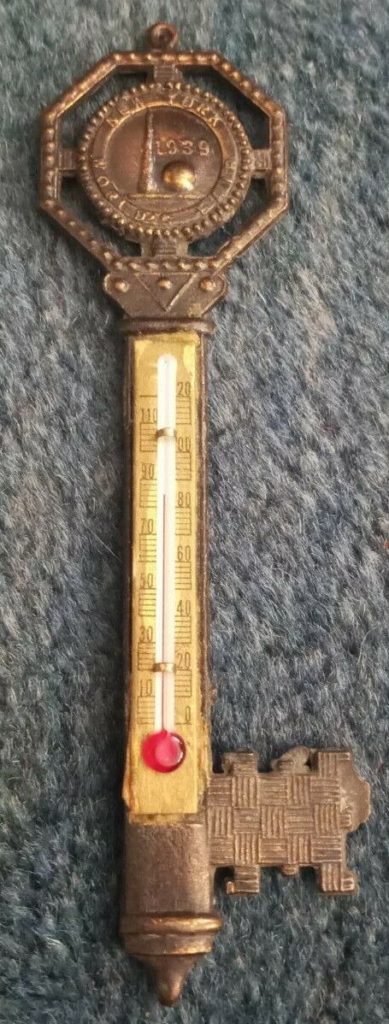
1939 World’s Fair key thermometer with Trylon & Perisphere monuments on top.
Continuing the innovative theme, along with “Peace Through Understanding” is a 1964-1965 World’s Fair thermometer, which featured an embossed brass Unisphere, mounted on wood.
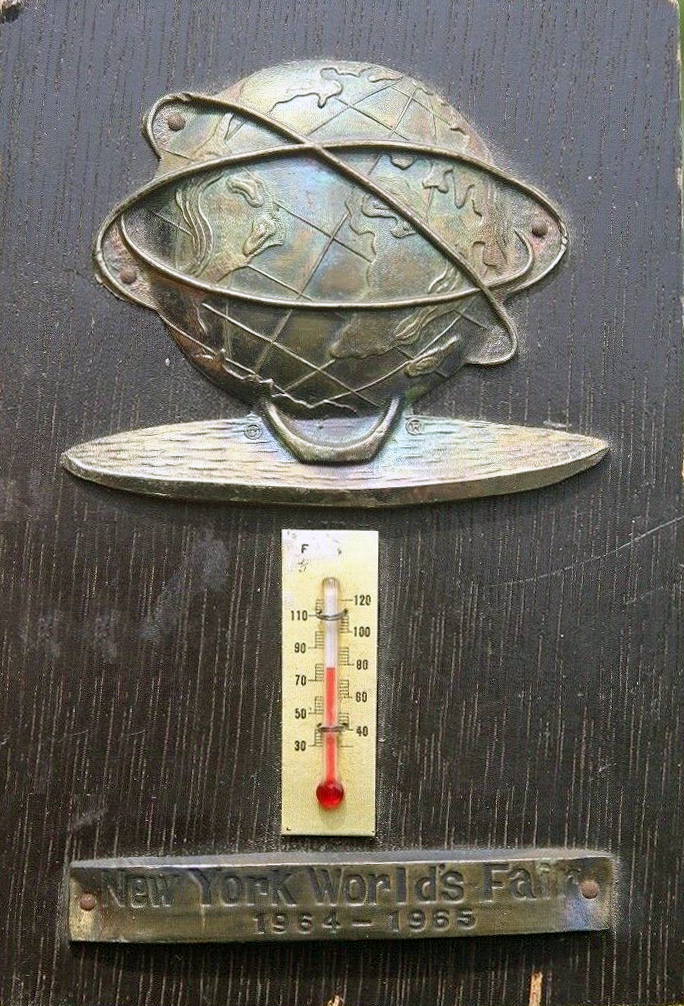
1964 – 1965 World’s Fair advertising thermometer.
Some advertising thermometers take the viewer to the great outdoors, as in the case of the circa 1940s “Lawrence Brown Prime Meat Market” thermometer, which features a watercolor-inspired scene of a Tudor cottage and a lush garden overlooking a lake with ducks.
This neighborly business was situated at 92-07 63rd Drive in Rego Park and memorializes the vintage prefix phone number found in HAvemeyer 4-0850.
The frame features unique Art Deco motifs.
In the 1950s, it became “Consumers Meat Market,” which longtime and former residents recall more so, but that too is long-gone.
“I enjoy looking at the wide variety of these thermometers available on the second-hand market,” said David Barnett, co-founder of Noble Signs and the New York Sign Museum.
“They showcase many styles of design and lettering. Some were distributed to shops and others as keepsakes directly to consumers. The practical value of a thermometer in a pre-digital age helped increase the likelihood that the advertisement would be saved instead of discarded.”
Now if you are not a collector, perhaps the foundation for an intriguing journey is about to begin


